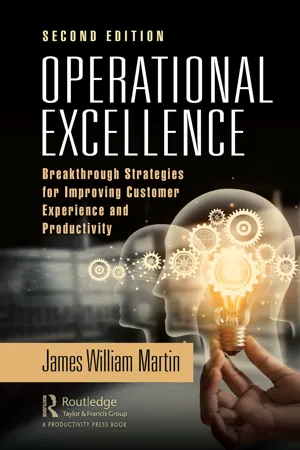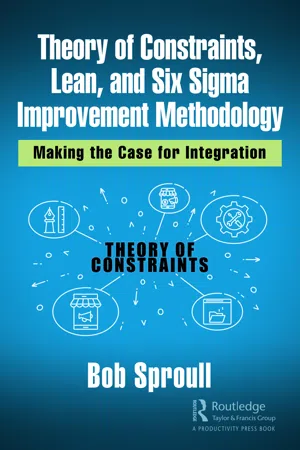Technology & Engineering
Six Sigma Methodology
Six Sigma Methodology is a data-driven approach used to improve processes by identifying and eliminating defects or errors. It focuses on reducing variation and improving efficiency, ultimately leading to better quality and customer satisfaction. The methodology uses statistical tools and techniques to measure and analyze performance, aiming for a standard deviation of six sigma from the mean.
Written by Perlego with AI-assistance
Related key terms
Related key terms
1 of 4
Related key terms
1 of 3
10 Key excerpts on "Six Sigma Methodology"
- Hasan Akpolat(Author)
- 2017(Publication Date)
- Routledge(Publisher)
The name ‘Six Sigma’ is derived from the use of standard deviation as a measure of defect levels in manufacturing processes. Using the Motorola definition, a process operating at six- sigma level (six times sigma) would mean less than four defects per million opportunities, a level close to perfection.The Six Sigma Methodology is a result of the evolutionary process of quality innovations from the 1930s through TQC, ISO 9000 and TQM. It is a business concept that combines quality improvement tools with strategic management processes to drive a company’s continual improvement efforts and achieve substantial bottom-line results.The strength of Six Sigma lies in the fact that:- it is truly an open management technology and is not managed or owned by anyone
- it can be easily customized by any implementing organization to suit various management goals
- it is not merely focused on defect reduction but can be applied to all areas of business including transactional and service environments
- it is supported by a well-defined toolbox for measurement and analysing processes employed
- it creates a platform for internal and external communication where experiences and knowledge can be shared.
Many organizations use Six Sigma not as a stand-alone system but integrated with other management practices, such as the ISO 9000 quality system, BPM, TQM or Business Excellence, as they complement each other.Passage contains an image
2 Foundations of Six Sigma: Customer and ProcessesIntroduction
No organization can survive without customers. Together with process, customers are considered to be the foundation of Six Sigma. It is necessary to identify who they are, what they need and what processes are required to satisfy those needs. Six Sigma recognizes the duality of customer and process and provides the mechanisms for ensuring that this relationship is established, maintained and strengthened.In this chapter we first explore who the customers are, what they expect and how to measure their needs and their satisfaction. Process thinking as the underlying concept of Six Sigma is discussed by first exploring processes as an abstraction and then providing answers to fundamental questions such as how to define processes and how to map, measure and improve them.- eBook - ePub
Statistical and Managerial Techniques for Six Sigma Methodology
Theory and Application
- Stefano Barone, Eva Lo Franco(Authors)
- 2012(Publication Date)
- For Dummies(Publisher)
Smith (2001) developed a very interesting insight of the evolution of Six Sigma in product development. In organisations where Six Sigma has become established as an approach to manage processes, people tend to identify it with a management philosophy that permeates all activities. In this sense it is considered the paradigm for innovation in the strategic management of organisations of the new millennium (Park, 2003), the successor to the Total Quality Management (TQM), which in turn had replaced the Total Quality Control (TQC), In fact, Six Sigma can certainly be considered as a fruit of earlier decades of philosophical and methodological evolution of the concept of quality. The evolution of Six Sigma is continuing, and one of the most recent developments is the Lean Six Sigma Methodology combining the two approaches of Lean Production and Six Sigma.The lean approach aims to ‘rapidly respond to changing customer demands and to create more value at a lower cost’ (Womack and Jones, 1996). It was established in manufacturing (lean production) and has gradually spread to other areas of management. The lean methodology is characterised by five steps: (i) to identify what the customer really perceives as value; (ii) to line up value-creating activities for a specific product/service along a value stream; (iii) to eliminate activities that do not add value; (iv) to create a flow condition in which the product/service advances smoothly and rapidly at the pull of the customer and (v) to speed up the cycle of improvement in pursuit of perfection (Su, Chiang and Chang, 2006).1.2.5 Six Sigma: Some Definitions
This section gives a definition of Six Sigma developed by the authors, and then provides definitions that appear significant for the attention given to certain aspects of a concept, which is undoubtedly complex to summarise.Today the term Six Sigma, in addition to clearly evoking a measure of aspired defect/fault reduction, identifies a strategic programme of continuous improvement characterised by defined stages and the use of statistical and managerial tools. Its aim is to reduce the undesired variability of process and product performances, and the costs associated with it, in order to increase customer satisfaction and increase market share. This definition emphasises that different aspects are equally relevant.- 1. The term programme shows that the design of Six Sigma has to follow the process logic through the clear identification of all the elements that characterise it as such (input, output, customers, etc.), and also follow the execution of a clear set of phases (e.g. DMAIC).
- 2.
- eBook - ePub
- Cary Adams, Praveen Gupta, Charlie Wilson(Authors)
- 2007(Publication Date)
- Routledge(Publisher)
15
Six Sigma and Quality Systems
Six Sigma, a customer-oriented methodology to maximize an organization’s profitability while producing the highest quality product, consists of two key components: methodology and measurements. Methodology is customercentric and focuses on improving processes to achieve desired results. Measurements are in place to ensure that the methodology works—easier said than done! In the current Six Sigma environment, methodology has become a projectbased institutionalization of process improvement. Considering the successes and failures of well-known corporations, it is clear that leadership, goal setting, and measurement are the key factors that make Six Sigma work. Leadership emphasizes the cultural aspects of the methodology, goal setting lays the groundwork for aggressive improvement, and measurement is a verification of the improvement.To ensure that desired improvements are achieved, measurements for profitability, quality, timeliness, cost, and customer satisfaction must be in place. The first step in implementing Six Sigma is to assess the state of the business (methods, material, machines, and employees), to identify strengths and opportunities, and to establish a baseline for key measurements. For areas with opportunity for improvement, establish improvement objectives prior to implementation of Six Sigma Methodology.The first challenge of the process is to identify the aspects of the business that should be measured. What is the simplest way to determine important aspects? Ask why. If the quality of a product or service is important, ask why quality is important to the company. The following questions may help your company to explore and identify desired measurements:• Business objectives. Why is a product, process, or business characteristic important to the business? • Success factors. What goals should be achieved? • Input measurements. What is needed to achieve these goals? • Process measurements. How are these goals achieved? - eBook - ePub
- Paul M. Griffin, Harriet B. Nembhard, Christopher J. DeFlitch, Nathaniel D. Bastian, Hyojung Kang, David A. Munoz(Authors)
- 2016(Publication Date)
- Wiley(Publisher)
At many organizations Six Sigma has come to represent a philosophy of striving for perfection. This philosophy stemmed from its development at Motorola in the early 1980s to improve product reliability 10-fold in a five-year period (Samuels & Adomitis (2003). As they set about achieving this goal, engineers viewed reliability as inversely proportional to errors or defects per million opportunities (DPM) in a process. In statistical terms, Six Sigma marks a high efficacy standard: 3.4 DPMO. General systems theory creates a relationship between all or nearly all of the processes in an organization. Motorola's striving for Six Sigma performance in its technical operations began to pervade every operation in the organization, and in 1988 it was awarded the Malcolm Baldrige National Quality Award for its accomplishments. The receipt of this honor prompted Motorola to release its proprietary control of Six Sigma and share the methodology with other businesses (Carrigan & Kujawa, 2006).Subsequently, General Electric CEO Jack Welch became a very well-known proponent of Six Sigma. He integrated Six Sigma into the corporate culture of GE and used it to drive GE's strategy goal of being number 1 or 2 in every market in which it had products. Welch initiated a tremendous quality campaign in his organization and announced:We want to change the competitive landscape by being not just better than our competitors, but by taking quality to a whole new level. We want to make our quality so special, so valuable to our customers, so important to their success, that our products become their only real value choice. (Snee & Hoerl, 2003)Now, Six Sigma is characterized by its customer-driven approach, emphasis on decision making based on careful analysis of quantitative data, and a priority on cost reduction. Six Sigma is deployed through the careful execution of improvement projects. Project selection should be based on a translation of the company strategy into operational goals. Six Sigma provides an organizational structure of project owners and project leaders. Members of upper management are project owners, or Champions. Project leaders are called Master Black Belts or Black Belts. Green Belts and Yellow Belts provide contextual support for the project. - eBook - ePub
- Larry Webber, Michael Wallace(Authors)
- 2011(Publication Date)
- For Dummies(Publisher)
Chapter 17
Fixing Tough Problems with Six Sigma
In This Chapter
Recognizing the basic principles of Six SigmaPreparing for Six Sigma implementationWalking through the Six Sigma stepsLooking at the numbers behind Six SigmaUsing a variety of process-review toolsE veryone has had a job where some part of it has never worked right — a persistent problem that annoys everyone but doesn’t seem to have an obvious cause. From time to time, someone tests a solution, but nothing seems to work. If a company has a stubborn problem — something that employees have to work around — then Six Sigma may be the answer to their prayers.Six Sigma is a collection of quality improvement techniques that identify the root causes of problems in production or service-delivery processes. It uses quality-analysis techniques and a broad application of statistics to pinpoint the process inputs that cause the undesired outputs. The techniques work to minimize the variation of inputs and produce more consistent products.Some quality improvement techniques, such as the Total Quality Management (TQM) method that we describe in Chapter 16, seek to make small improvements that add up over time to a big improvement. Six Sigma, however, focuses on breakthrough improvements. It’s the best tool for fixing those stubborn, they’ve-always-been-this-way problems.In this chapter, we cover the basic principles of Six Sigma, walk you through the main steps, and give you a few important formulas (including what the “sigma” actually means). We also explain how your organization can use a few analysis tools and introduce you to some advanced variations of Six Sigma. For more information on the Six Sigma method, check out Six Sigma For Dummies, by Craig Gygi, Neil DeCarlo, and Bruce Williams (Wiley).A sigma - eBook - ePub
Operational Excellence
Breakthrough Strategies for Improving Customer Experience and Productivity
- James Martin(Author)
- 2021(Publication Date)
- Productivity Press(Publisher)
Six Sigma is a top-down alignment versus the bottom-up approach that is a characteristic of TQM. A second advantage is that Six Sigma provides significant business benefits for organizations, and these benefits can be realized relatively quickly once projects are deployed. As a result, TQM was augmented by Six Sigma in the mid-1990s. Different organizations approach quality improvement from either a TQM focus with Six Sigma augmentation or vice versa. Six Sigma has often been deployed as a project-based initiative that must be integrated into an organization's quality assurance systems. A reliance on Six Sigma alone to improve and sustain process improvements is risky because, in the absence of formal quality systems and TQM, in which most employees are trained, Six Sigma process improvements will deteriorate over time. The program was always designed to include a fraction of employees to achieve breakthrough improvement while most employees engage in continuous improvement.The concept of “breakthrough” improvements in quality and aligning projects with goals that are important to leadership helps secure resources for projects. Figure 9.3 shows important characteristics of an effective Six Sigma program. The deliverables are achieved using the five Six Sigma phases: define, measure, analyze, improve, and control (DMAIC). The DMAIC phases are further expanded into ten to twelve steps (depending on the organization), with each step having key deliverables. Over an extended period, an organization will mature into a Six Sigma performing culture if it has quality assurance and management infrastructure that supports continual improvement.FIGURE 9.3Key characteristics of Six Sigma. Six Sigma helps organizations make the transition from tactical problem solving to business process development and customer excellence.The DMAIC methodology is applied to improve the performance of customer critical-to characteristics (CTs). Figure 9.4 - eBook - ePub
Six Sigma for Students
A Problem-Solving Methodology
- Fatma Pakdil(Author)
- 2020(Publication Date)
- Palgrave Macmillan(Publisher)
improvement methodologies were developed in practice and academia over the last decades, and one of those methodologies is Six Sigma. Quality, and specifically the Six Sigma concept, became a scientific discipline with its own vocabulary, terminology, techniques, rules, and norms. The Six Sigma concept was constructed from the advances of quality concept and total quality management.The history and origin of quality started at the beginning of human civilization. The quality term has a long historical background that goes to the Code of Hammurabi in early 2000 BC and is considered to be the first structured quality standard. According to the Code, “If a builder has built a house for a man, and his work is not strong, and the house falls in and kills the householder, that builder shall be slain.”Quality still has the same meaning today. What is perhaps different today is the focus on a structured quality approach, that is, a quality plan that is well articulated, included in operational strategies, and integrated in a decision-making framework to attain predefined goals. Keeping this in mind, quality has become a powerful tool through which organizations can achieve competitiveness and survival in the marketplace. This structured approach to quality has helped many leading corporations such as Xerox, Motorola , IBM, Harley-Davidson, and a host of others to survive and thrive in their competitive environment (Madu 1998 ).Some researchers (c.f. Benedetto 2003 ) asserted that the root of Six Sigma could be credited to the early nineteenth century, when Gaussian/normal distribution and sigma was developed as a measurement standard. Prior to the mass production era in the late 1800s, quality heavily relied on craftsmen and operators’ skills, abilities, and knowledge and was known as operator quality control . In the early 1900s, foreman quality control - eBook - ePub
The Excellent Education System
Using Six Sigma to Transform Schools
- Daniel Bloom(Author)
- 2017(Publication Date)
- Productivity Press(Publisher)
Chapter 4 Six Sigma ToolboxAs I explained in Chapter 1 , we have undertaken a journey to transform our schools into a new business model centered on the business strategic initiatives of the educational institution. In Chapter 3 , I gave you a brief overview of what this methodology we call Six Sigma is. Our primary point was that it was a proven methodology. In the previous chapter, I discussed what Six Sigma is and why it is important to your school. One of these points was that the Six Sigma Methodology is a proven, accurate tool for guiding an organization through the process of resolving issues. However, the process only works when you have a set of tools to get you there. Like I did with the bell curve in Chapter 3 , I can provide you with a model for that process.Take yourself back in time to your high school science classes. I am willing to bet (and I am not a betting person) that every one of your science classes began with a discussion of the scientific method. If you don’t remember precisely don’t fret, just know that it was done. I taught science for 6 years, and I started out every class with this very discussion. The scientific method was designed to provide us with a standard method of solving experiments that took place within the lab. It consisted of a sequential series of steps that took you through the experiment (Figure 4.1 ).Figure 4.1 Scientific method. (From http://www.experiment-resources.com/what-is-the-scientific-method.html.)The scientific method is based on creditable, verifiable facts and data, which are developed as you walk through the experiment before you. The first step is that you formulate a question. - The statistical model provides the marketing name for the Six Sigma improvement initiative. Its effectiveness is indicated by the tremendous interest shown in, and take-up of, the Six Sigma business process throughout the world. That Six Sigma has considerable substance is borne out by the fact of positive news-feed from organizations already committed to Six Sigma.
- A number of statisticians are extremely critical of some of the statistical features of the model. These criticisms have been aired in this chapter and positive responses given. These responses are intended to be helpful to those engaged, currently and potentially, in Six Sigma activities.
- It should be borne in mind that the five constructive criticisms made in respect of the statistical component of the Six Sigma initiative is not associated with, or detracts from the benefits gained by deployment of, the overall Six Sigma business improvement process itself.
– One should be careful to distinguish between the universally used Greek term for standard deviation namely, sigma, and the Sigma used by Six Sigma practitioners. The smaller the value of standard deviation, sigma, the better the precision (performance) of a process. The larger the ‘Sigma’ the better the performance of the process.– It is recommended that anyone and everyone associated with Six Sigma use the accepted linkage between ‘defects’ per million opportunities and the Sigma measure purely for convenience in respect to what is now accepted common usage in the Six Sigma arena. They should, however, not be taken in by the very tenuous arguments put forward to justify this relationship.– The name Six Sigma is a marketing concept for a continual-improvement initiative that aims to provide a somewhat arbitrary amount of clear water between a 6 Sigma performance standard and current standard practice. A 6 Sigma standard is commonly said to represent a world-class performance of 3.4 ‘defects’ per million opportunities.– The originators of Six Sigma use the term ‘defect’ to describe the universally accepted term ‘non-conformities’. The perpetuation of this practice by many Six Sigma authors, trainers and practitioners is strongly discouraged. The International Standards Organization explicitly state that the term ‘defects’ should be used with extreme caution, primarily because of legal and product liability implications.– In general Six Sigma practice, the term opportunity is said to apply to a critical-to-quality characteristic (CTQC). A Sigma level in a given situation is determined by the number of non-conformities per million opportunites (NPMO). If NPMO is to be a universal metric, as claimed, extreme care should be taken on what a CTQC is. This is because of the sensitivity of NPMO, and hence the Sigma level, to number of CTQCs.- eBook - ePub
Theory of Constraints, Lean, and Six Sigma Improvement Methodology
Making the Case for Integration
- Bob Sproull(Author)
- 2019(Publication Date)
- Productivity Press(Publisher)
3What Is Thi s Thing Called Six Sigma?Six Sigma Principles, Tools, and Methods
When I read one of my first books on Six Sigma, there was one quote that drove home what Six Sigma is all about, at least for me. Mikel Harry told us something about the power of measurements with the following [1 ]:To know the truth is to know all of the facts. To know the facts requires investigation. Investigation is driven by questions. A question (Q) always precedes an answer (A), thus A = f (Q). Questions lead, and answers follow. Without the question, an answer is merely information, not an answer. The same question invariably leads to the same answer. To change the answer is to change the question. We won’t change the question without reason to do so. We can only reason from what we know. What we know is based on facts. Every fact is an answer to some question. Facts are discovered, not created.These words, although elegant and simple, deliver a very compelling message to all of us about first questioning, then searching for answers, and then measuring to find the answers. The fact is, if we don’t measure, we simply will not improve. This is the powerful and dynamic message of Six Sigma. Wheeler and Chambers explain, “You can make calculated guesses and assumptions based on experience, but without hard data, conclusions are based on insufficient evidence” [2 ]. Or maybe a simpler message is, “Without data you’re just another person with an opinion.”The first step in the Six Sigma roadmap is the identification of core or primary processes and key customers. As a rule of thumb, most companies have four to eight really high-level, essential core processes that represent the backbone of how the company functions. These typically include things like customer acquisition, order administration, order fulfillment, customer service and support, new product/service development, and invoicing and collections. If you consider each of these in the context of the goal of the company, to make money now and in the future, and although they all contribute, each could also be a system constraint. If you were, for example, producing product and shipping it according to order rates, but you were not receiving the revenue in a timely manner, then invoicing and collections could be the operation that is constraining or restricting your organization’s revenue stream. Or maybe your order fulfillment process is preventing you from moving closer to your goal.
Index pages curate the most relevant extracts from our library of academic textbooks. They’ve been created using an in-house natural language model (NLM), each adding context and meaning to key research topics.
Explore more topic indexes
Explore more topic indexes
1 of 6
Explore more topic indexes
1 of 4









